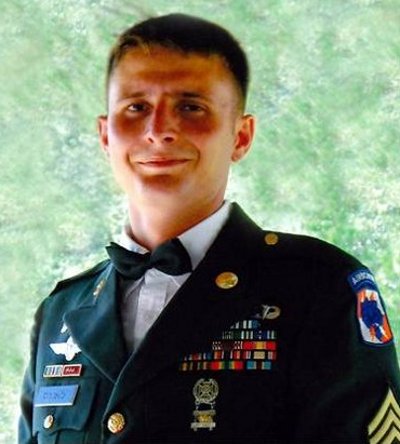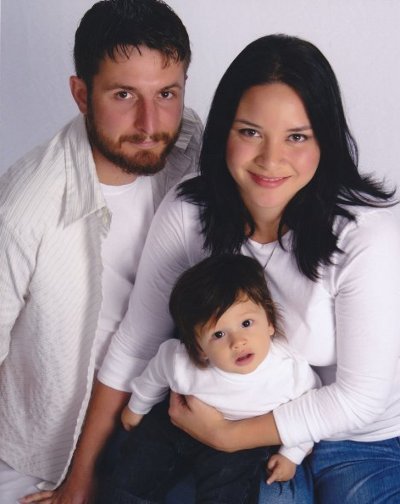
Sgt. 1st Class David Hartman was killed in Pakistan on February 3, 2010. He will be laid to rest at Arlington National Cemetery in Arlington, Virginia, on Wednesday, April 7, 2010.
KELSEYVILLE – In the coming week, the Hartman family of Kelseyville will make one of the hardest journeys any family could.
They will fly to Washington, DC, and from there trek to Arlington National Cemetery, where this Wednesday, April 7, Sgt. 1st Class David Hartman – their son, brother, grandson and nephew – will be buried will all of the military honors his country can bestow on him.
The 27-year-old Hartman, a young man who had served close to a decade in the military and planned to make it his career, was killed in Pakistan on Feb. 3, along with two military colleagues, as Lake County News has reported.
Hartman and his fellow soldiers were riding in a SUV, on the way to the opening of a girls school, which had been rebuilt with US government funds set aside for the purpose, when their vehicle hit a roadside bomb. His family said he had recently moved into civil affairs, a division of US Special Forces.
He was on a humanitarian mission in Pakistan, although his family said he couldn't – and didn't – say much about his activities and where they occurred.
Just what happened that day is supposed to be contained in a US Army report that Greg Hartman, David's father and a local minister and contractor, is supposed to receive at its completion.
The family said they've heard many different stories about that final day in David Hartman's life, which was shrouded in secrecy. Initially, Greg Hartman said his son was said to be a journalist, not a member of the US military.
David Hartman received the Bronze Star and Purple Heart posthumously, Greg Hartman said.
Since David Hartman's death, his family has experienced what they can only call an “overwhelming” outpouring of emotional, spiritual and financial support from the community.
“You don't know how many good people are out there until something like this happens,” said his sister, Ladona Hartman.
The Lake County community has stepped up to try to help alleviate the family's financial needs when it comes making the trip to the East Coast for the funeral.
The week after David Hartman's death, Operation Tango Mike – a local group that offers support to troops overseas and their families here at home – began a fundraising effort to assist the family with travel.
OTM's founder, Ginny Craven, said she set a goal of $5,000 which, considering the current economic times, she said she felt was lofty.
All told, Craven said the family has received just over $10,000. She said OTM helped raised around $9,000 through general fundraising and a a pancake breakfast late last month that, all by itself, raised about $2,400.
The family received about $1,000 more directly. Umpqua Bank set up an account to take funds directly from community members who wanted to walk in with donations, Craven said.
Craven said it's the first time OTM has raised so much money for one fundraising effort. “It's the first time we've had this kind of need,” she said, noting the need was immediate.
She added that the community's generosity “was just amazing to me.”
That generosity will allow seven extended family members to make the trip along with the immediate family, said the Hartmans, who all agreed in calling Craven “amazing” for her help.
Lake County embraces family
The Hartmans are a family of music – most play and sing some kind of instrument – as well as ministry, which is what brought them to Lake County beginning about 15 years ago.
Alvin and Ladona Hartman, David Hartman's grandparents, were the first members of the family to arrive in Lake County. They pastored a church in Finley for 14 years before retiring last June.
Greg Hartman and his wife, Kate, arrived about 12 years ago to work with a ministry, Freedom Worship and Education Center in the Clear Lake Riviera, www.fwec.net/ .
David's sister Ladona later came to visit, liked it and stayed. She works as a phlebotomist at Sutter Lakeside Hospital, and noted that her employer and co-workers have been incredibly generous – in donating vacation time and money – to help her out following her brother's death.
David and Ladona Hartman lived with their mother and stepfather, who was in the military, on Okinawa, where the two young Hartmans went to high school. His future wife, Cherise, also went to school there. That school is naming its new ROTC building after David Hartman, Ladona Hartman said.
Immediately after graduating from high school, David Hartman – influenced by his stepfather – joined the military, entering on June 22, 2000, his sister explained.
He would serve tours in Iraq and Afghanistan, and last year he changed tested to move into civil affairs, where he would make a better living for his wife and children and be able to help people more, he told his family.
Despite the dangerous places where he served, “He always told us he was safe,” said father, Greg Hartman. At one point David Hartman told his family that no US soldiers had been killed in Pakistan, so they shouldn't worry.
David Hartman visited Lake County and enjoyed fishing and playing golf. He was in Lake County last summer, one of his last visits home, his family said.
“I knew when I hugged him I wasn't going to see him again,” said grandfather, Alvin Hartman, who shed tears at the memory.
When he left for duty this past fall, David Hartman had grown a beard to blend in more with the citizenry, was speaking the language and acted as a liaison between the people and the military.

Four Hartman family generations: From left, Alvin Hartman, David Hartman's grandfather; David Hartman, Pastor Greg Hartman and Mikey Hartman, David's son. Taken in the summer of 2009 at the home of grandparents Alvin and Ladona Hartman in Kelseyville. Photo courtesy of Ladona Hartman, David Hartman's sister.
Earlier this year, his mother, Mikail Bacon, who now lives in Wisconsin, had traveled to Los Banos, where David Hartman spent part of his childhood, to visit with her elderly parents. The day David Hartman died they were able to talk to him via Skype, as he was getting ready to leave.
Greg Hartman was at work when the military showed up to his door to give him the news. His younger daughter, Bethany, called him on his cell phone, and as he was heading home, daughter Ladona called after getting the news from her mother.
Greg Hartman went to Dover Air Force Base in Dover, Delaware, in the days after his son's death for the dignified transfer of his body to the United States. In April 2009, President Barack Obama had ordered the military to take any families who wanted to be present for the dignified transfer of their loved ones' bodies to Dover, Hartman explained.
“That was the hardest thing I've ever had to do,” he said.
When David Hartman's body was transferred south to Los Banos for his Feb. 17 funeral, his family said the Army and Patriot Guard Riders worked with the California Highway Patrol and other law enforcement agencies for an unforgettable procession. Riding along to honor the young soldier were CHP and San Jose Police officers on motorcycles and in cars.
As they passed through San Francisco, the on ramps to the freeway were blocked to let the hearse pass, Hartman's family said.
Since David Hartman's death occurred, the family has been receiving condolence cards from all over the world, including notes of condolence from the chair of the Joint Chiefs of Staff and President Obama.
Assemblyman Wes Chesbro sent the family a copy of a resolution that names Highway 53 a Veterans Memorial Highway, and which mentions David Hartman.
Then the military offered to have David Hartman buried at Arlington National Cemetery and Cherise Hartman accepted, wanting him to have all the honors afforded him.
The cemetery, overlooking the Potomac River, is one of the most sacred military burial sites in the United States.
The land once belonged to the descendants of Martha Custis Washington, wife of George Washington. Eventually, the land came to belong to Mary Anna Custis Lee, wife of Gen. Robert E. Lee, the leading general of the Confederacy, according to a cemetery history.
The land was confiscated by the federal government for unpaid taxes, sold at auction in 1864 and purchased for government use, with the cemetery established later that year.
Greg Hartman said he's received a lot of praise for his son from officers of higher rank in the military. David Hartman was a sergeant first class about 10 years ahead of most. “My son was doing really well in the military,” he said. “He was making a good impression on his superiors.”
David Hartman and his wife were married May 17, 2007. Together they have a young son together, Mikey – who turned 1 year old three days after his father's death. A baby daughter, Catherine Isis, is due this July 1.
The couple had built a home together in Rayford, North Carolina, where Cherise Hartman plans to stay for awhile so that her children can grow up in the home their father built for them.
“She's having a real hard time,” said Greg Hartman.

Portrait of a young family: David and Cherise Hartman and their young son, Mikey, in a picture taken in late 2009. Cherise Hartman is expecting a baby girl this summer. Photo courtesy of the Hartman family.
Looking for good amidst tragedy
David Hartman was a grown man, off on his own in the world, and his family didn't see him everyday. However, for them, one of the great heartaches is knowing the quiet, serious young man won't be coming for visits, and they can't tell him they love him.
“God has to be the fixer,” said Alvin Hartman.
It's already providing opportunities to touch lives. “I'm finding I'm ministering to a lot more people because of this,” said Greg Hartman.
He added, “It's amazing how much this really touches people.”
David Hartman's sister, Ladona, will miss calling her older brother for advice, and spending time together, like they did when he visited Lake County last summer, when she was able to take several weeks off to visit.
“David loved his family,” his father remembered.
They explained that when they talk to people about David Hartman, many people start to cry.
David Hartman's family also is convinced that God will bring good out of this tragedy.
The family plans to give more of its time to helping Operation Tango Mike and Craven. David Hartman's grandmother, Ladona, and sister said they plan to assist with OTM packing parties, and grandfather Alvin Hartman has offered his services as a chaplain.
The family said they could never offer the community enough thanks for its kindness.
A memorial Facebook page for David Hartman, created by his 14-year-old sister Bethany, can be found at www.facebook.com/pages/Lake-County-News/143156775604?ref=ts#!/pages/In-Memory-of-Sergeant-1st-Class-David-James-Hartman/295594093994?ref=ts .
E-mail Elizabeth Larson at This email address is being protected from spambots. You need JavaScript enabled to view it. . Follow Lake County News on Twitter at http://twitter.com/LakeCoNews and on Facebook at http://www.facebook.com/pages/Lake-County-News/143156775604?ref=mf .

 How to resolve AdBlock issue?
How to resolve AdBlock issue? 












